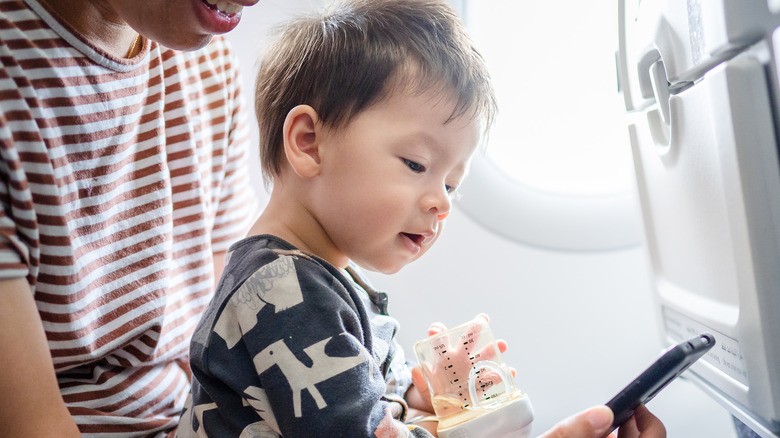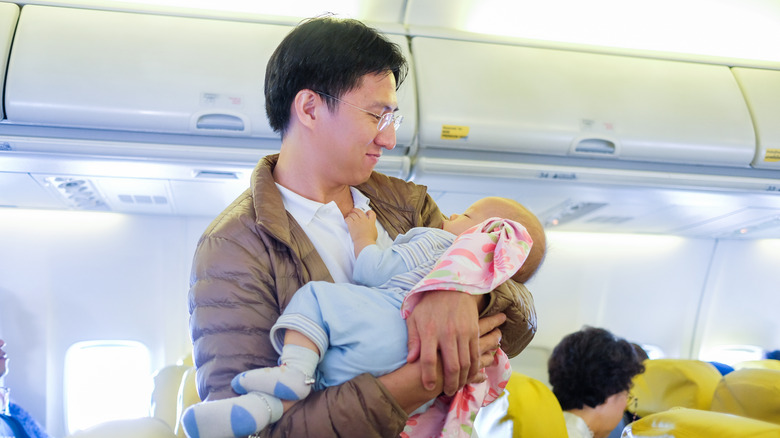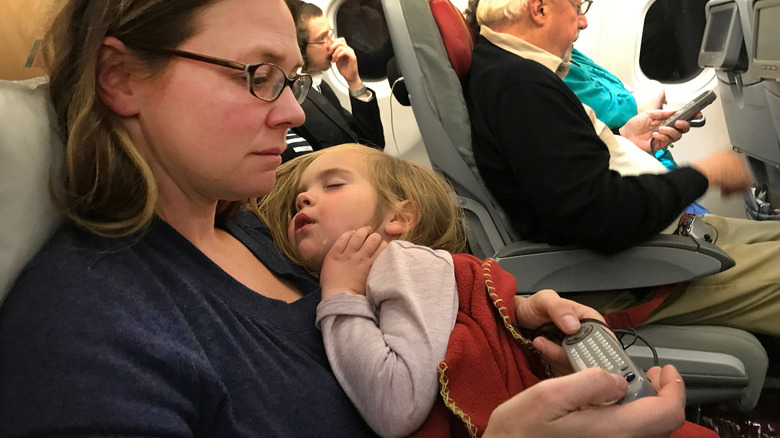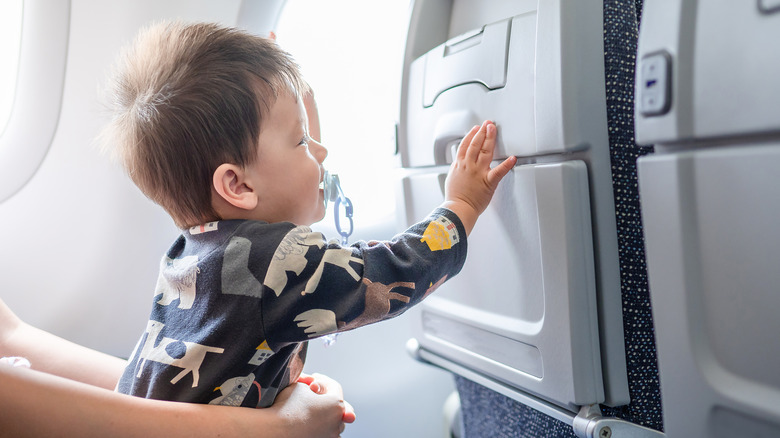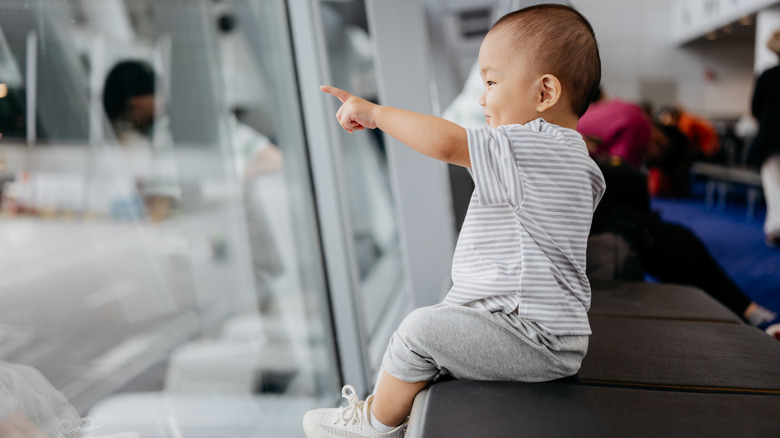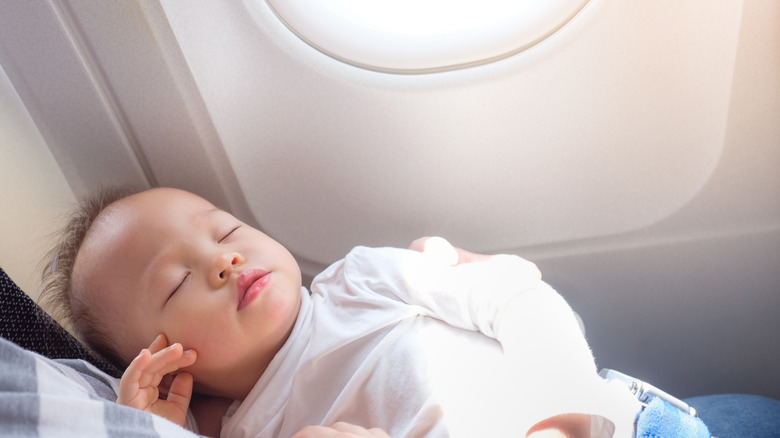What To Consider Before Flying With A Lap Child
Before anything else, let's just get this out of the way: The TSA does not recommend flying with a lap child for safety reasons. Instead, the agency strongly urges parents to fly with a car seat. But doing so would generally mean paying for an extra seat — something that takes a cut out of your travel budget. So, we totally understand if you'd rather fly with a lap child instead.
A lap seat is a viable option as long as your child is still below the age of 2. Otherwise, they'll have to fly with a paid ticket too. Thankfully, many family-friendly airlines have policies in place that make flying with children smoother. So, with a bit of planning, flying with a lap child can be convenient and comfortable for both you and your baby. With that being said, you have to think about many things before jumping on the decision to avail of a lap seat. Here are some of the important considerations to keep in mind.
Airline lap child policies
Airlines typically have policies that lean toward making family flight easy and convenient. However, they can and do change their policies from time to time, so checking your airline's lap child policy before booking your ticket should always be something you do first and foremost. Plus, these policies might vary from airline to airline, so a little research can go a long way.
As mentioned, airlines don't normally charge for a lap seat on a domestic flight, but most require that you add your child to an adult ticket. This adult could be you, your spouse, or some other caretaker. Airlines strictly implement this one adult, one lap child rule, so if you have more than one child during a flight, you'll need to buy an extra seat. That is, you can only hold one child in your lap and the other one must occupy another seat. If you're traveling with another adult, say your spouse, you can split the children between you, but you can't sit in the same row together.
On an international flight, however, airlines will usually charge you taxes and fees and/or 10% of the fare. Ticket prices fluctuate so this can be anywhere from a few hundred dollars or more. And, it's especially tricky when it comes to using miles, as airlines have different redemption policies. Again, check with your airline regarding these.
Where to seat a lap child
Similar to flying with a car seat, your seat options when flying with a lap child are limited. Because of this, booking your seat in advance ensures you'll be seated comfortably and in your preferred location. An aisle seat can let you freely get up and out, but a window seat means away from possible danger of falling or hot objects. But again, seat options vary from airline to airline so always check with them first. Typically, you won't be allowed to sit with a lap child in an emergency exit row, or the rows in front of or behind that. Advance booking and notification about a lap child also increases the chances of having the seat next to you unoccupied, unless it's a full or busy flight.
And, you should remember the under 2 rule. Otherwise, you might end up paying for an extra ticket you did not plan for. So, always take note of your child's birthday when you travel because if your flight falls on their 2nd birthday, they'll need a paid ticket too.
If you're in for a long flight, consider booking either a nonstop flight or one with a longer layover. With a nonstop flight, you'll only board once, while sandwiching a longer layover between flights allows you some time to breathe. You don't have to run with your baby and/or baby paraphernalia from one gate to the next. And, you can use the extra time to take care of your baby's needs and maybe even relax a bit.
What to pack
When you have an infant or toddler, it's normal to bring tons of stuff wherever you go. Air travel is no exception. But because your child is flying for free, most airlines don't provide them any checked luggage allowance. So, any baggage you check in — whether it's for you or your baby — will count toward your luggage allowance. As always, check your airline's baggage policies. Fortunately, most airlines provide one free checked bag, with Southwest being an outlier allowing two free checked bags. Most airlines also allow you to check car seats and strollers for free. Plus, you can bring diaper bags as part of your carry-on allowance (or in addition to on some airlines).
Extra clothing and diapers, milk, food, and other baby supplies are essential to have on hand, so pack them in your carry-on or diaper bag. You can include their sleeping blanket, favorite toy, or lovey too. Basically, anything you might need to feed or nurse, clean, and keep your baby happy. You should also prepare for the possibility of delayed flights and lost bags by packing more than you need.
Another important item to pack is a document proving your child's age. This can be their passport, ID, or birth certificate. Make sure to double-check with your airline the documents they accept, and bring a copy with you and save a picture or file in your phone as well. If you can't prove your child's age, you might have to buy them a seat, which will be expensive.
Your child's comfort – and yours too!
Nobody wants a fussy or irritable baby, so comfort is a priority when you fly. Airplanes can get cold but outside, it might be warm. So, keep your child comfy by dressing them in layers. Think easily removable pieces of clothing, such as jackets, socks, hats, and maybe even bring a warm blanket. This goes for you too, i.e., dress with comfort and ease of movement in mind. Before boarding, do a quick diaper change in the airport restroom, which has more space than its plane counterpart, reducing the number of diaper changes you have to do onboard.
It's also a good idea to schedule your travel around your baby's nap time, so that they'll be able to sleep through the flight. Provide them with a noise-canceling headphone to help drown out the cabin and airplane noises. During takeoff and landing, feed or nurse your baby to avoid the dreaded ear popping and the crying that ensues. The sucking and chewing motions alleviate the pressure on their ears. But, if they do make a fuss and begin to cry, you can bring ear plugs for the other passengers. This isn't required, so do this only if you feel inclined.
And, aside from the items you need to pack, be sure to bring some form of entertainment for older children too. This could include mobile devices to watch their favorite shows and movies on, books, and toys. This will keep them distracted during the flight and give you some peaceful time to rest.
Other considerations
Like adults, children have different personalities, and as such, you should design your travel plans accordingly. Some might behave while others might not, and even the same baby can act differently on each plane ride. "I've done this a lot and sometimes it's great and other times it's ... less great. But either way you'll survive!" one parent commented on the Mommit Reddit thread.
The reality of flying with a baby — whether they're sitting in their car seat or on your lap – can be hard, so set realistic expectations and have the right mindset. As this user in Reddit's Beyond the Bump forum aptly put it: "Flying with a baby isn't meant to be easy, I guess, so it's just about accepting that and going on for the ride."
And, for the side glances or disgruntled looks from a few people who don't appreciate you bringing a young child on the flight, well, let it go. "The overwhelming majority of adults understand that babies are babies, and sometimes they're irrational AF and there is nothing you can do about it," another Beyond the Bump Reddit user noted. "Generally, as long as you're engaging with your kid and trying your best, 95% of people get it. And the others? Meh. You'll never see them again, don't worry about them." When it comes down to it, the flight is just a short portion of your travels, so it shouldn't set the tone for your entire trip.
